If you’re considering bulk meal storage for emergency preparedness, incorporating once-a-month cooking into your routine can be a transformative strategy. Not only does it ensure a stockpile of ready-to-eat meals, but it also streamlines your daily life, freeing up time otherwise spent on daily meal preparation.
Understanding Bulk Meal Storage for Emergency Preparedness
When it comes to emergency preparedness, having a reliable plan for food is essential. Bulk meal storage isn’t just about hoarding canned goods; it’s about having nutritious, home-cooked meals ready at a moment’s notice. This approach can be critical during power outages, natural disasters, or even when unexpected personal crises arise.
Getting Started with Once-a-Month Cooking
Once-a-month cooking, also known as freezer cooking, involves dedicating one day a month to preparing and cooking meals in bulk. These meals are then stored in the freezer, providing you with a variety of options that can be quickly reheated.
Plan Your Menu: Start by planning a menu of meals that freeze well. Consider dishes like lasagnas, soups, stews, casseroles, and marinated meats. Ensure you have a balanced variety that includes proteins, vegetables, and carbohydrates.
Gather Supplies: You’ll need freezer bags, aluminum foil, disposable baking pans, and a sharpie for labeling. Invest in quality containers that are both microwave and freezer safe.
Shop in Bulk: Once your menu is set, create a detailed shopping list. Buying in bulk can save money and reduce the frequency of shopping trips.
Prep and Cook: Designate your cooking day and start early. Prep vegetables, meats, and other ingredients first. Cook meals according to your menu, then let them cool to room temperature.
Freeze Properly: Portion your meals into family-sized or individual servings. Label each container with the date and meal type. Remove as much air as possible from freezer bags to prevent freezer burn.
Optimizing Your Freezer Space
Managing freezer space is crucial when practicing once-a-month cooking. Organize your freezer by type of meal or date prepared. Keep an inventory list on the freezer door to keep track of what’s inside and minimize waste.
Thawing and Reheating Your Meals
Plan your meals a day ahead by transferring them from the freezer to the refrigerator to thaw. This method ensures food safety and preserves the quality of the meal. When reheating, use the oven, stovetop, or microwave, depending on the meal.
Maintaining Quality and Taste
Properly wrapping and sealing meals is key to maintaining quality and taste. Use freezer-safe wrap and heavy-duty freezer bags. Including a small piece of wax paper on top of casseroles before sealing can help prevent freezer burn and preserve the meal’s moisture.
Regularly Rotate Your Meal Stock
Just like any food storage, it’s important to use a first-in, first-out system. Regularly rotating your meals ensures you consume the oldest items first, keeping your stock fresh and up-to-date for any emergency.
Once-a-month cooking is a proactive approach to meal planning that can significantly contribute to your emergency preparedness efforts. By mastering bulk meal storage, you secure a practical and efficient way to ensure your family has access to nutritious meals during times of need. With careful planning and organization, you can turn once-a-month cooking into a reliable resource for peace of mind.



